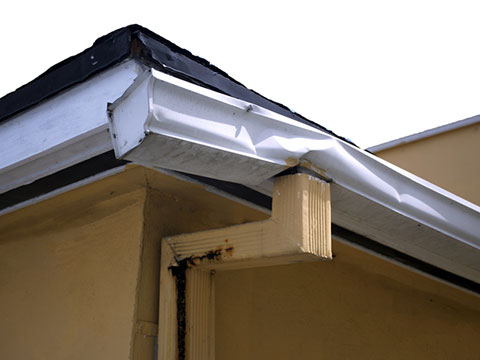Gutters are a crucial part of your home’s defense against water damage, but they’re often neglected until an issue arises. When your gutters are not functioning properly, they can lead to a range of problems, from water damage to foundation issues. Recognizing common gutter problems early on can help you avoid costly repairs and keep your home protected. Here’s a list of the most common gutter issues and what you can do to address them.
1. Clogged Gutters
Problem: Clogged gutters are the most common issue homeowners face. Leaves, twigs, dirt, and other debris can accumulate in the gutters, blocking the flow of water. When this happens, water overflows, potentially damaging your roof, siding, and foundation.
Solution: Regularly clean your gutters, especially in the fall and spring when debris is more likely to build up. Installing gutter guards can also help prevent clogs by keeping leaves and debris out while allowing water to flow through.
2. Sagging Gutters
Problem: Over time, gutters can begin to sag or pull away from the house due to the weight of debris or standing water. This happens when the gutter fasteners (hangers or spikes) fail, leaving the gutters unable to support their weight.
Solution: Check for loose or broken fasteners and replace them as needed. Ensure that the gutters are properly sloped toward the downspouts to prevent water from pooling, which contributes to sagging. You may need to upgrade to stronger hangers if your current system isn’t holding up.
3. Leaks and Holes
Problem: Leaks and holes can develop in your gutters due to corrosion, damage from debris, or simple wear and tear. Even small leaks can cause significant water damage over time, especially if they go unnoticed.
Solution: Use gutter sealant or patches to fix small holes or cracks. For larger holes, you may need to replace the damaged section of the gutter. Regular inspections can help you catch leaks before they become major problems.
4. Improper Slope
Problem: Gutters need to be installed with the correct slope to ensure water flows toward the downspouts. If the slope is too steep or too shallow, water may not drain properly, leading to overflow or standing water in the gutters.
Solution: Check the slope of your gutters by running water through them. If water isn’t flowing correctly, you may need to adjust the hangers to achieve the proper pitch (typically around 1/4 inch slope for every 10 feet of gutter).
5. Gutters Pulling Away From the Roof
Problem: Gutters can begin to pull away from the roof due to loose fasteners, improper installation, or excessive weight from debris or ice. This can cause the entire system to fail and may lead to water damage to the roof and walls.
Solution: Tighten or replace any loose fasteners. If the fascia board is damaged or rotting, you’ll need to repair or replace it before reattaching the gutters. Regular cleaning can also prevent excess weight from pulling the gutters away from the roof.
6. Downspouts Not Draining Properly
Problem: Downspouts that are clogged or improperly positioned can cause water to back up in the gutters or pool around your foundation, leading to erosion or basement flooding.
Solution: Make sure downspouts are free of clogs and extend at least 4-6 feet away from your home to direct water away from the foundation. You can also install splash blocks or downspout extensions to further guide water away from your home.
7. Rust and Corrosion
Problem: Older metal gutters, especially those made of steel, are prone to rust and corrosion. Once rust starts to form, it can spread quickly, leading to holes and leaks.
Solution: If rust is localized, you can sand down the affected area and apply a rust-inhibiting paint or sealant. However, if the rust is widespread, it may be time to replace the gutters with a more durable material like aluminum or copper, which are more resistant to rust.
8. Ice Dams in Winter
Problem: In cold climates, ice dams can form in your gutters during winter. Ice dams occur when snow melts off the roof, refreezes in the gutters, and blocks water from draining. This can lead to gutter damage and water backing up into your roof.
Solution: To prevent ice dams, ensure your attic is well-insulated to prevent heat from melting the snow on your roof. You can also install heat cables in your gutters to keep ice from forming or clean out the gutters before winter to minimize ice buildup.
9. Pests and Critters
Problem: Birds, squirrels, insects, and other critters often find gutters to be attractive nesting sites, which can lead to clogs and other problems.
Solution: Installing gutter guards can help keep pests out. You can also regularly inspect your gutters for signs of nesting and remove any debris that could attract animals.
10. Overflowing Gutters
Problem: Gutters that overflow during heavy rains may not be large enough to handle the volume of water or may be clogged.
Solution: Make sure your gutters are clear of debris, and check that they are sized correctly for your roof’s surface area. If the problem persists, you may need to upgrade to a larger gutter system to handle heavy rainfalls.
Conclusion
Regular gutter maintenance and inspections are key to preventing common problems that can lead to serious water damage. By addressing issues like clogs, leaks, and sagging early on, you can extend the life of your gutters and keep your home protected. If you’re unsure how to tackle a gutter problem or suspect major damage, it’s always best to call a professional for an inspection and repairs.
ABU Gutters is on hand with their team of skilled professionals who are fully qualified to perform maintenance works and damage repair to your gutters. The customer service team at ABU Gutters would be more than happy to get in touch with you and see how they are able to help get your gutters back into tip-top shape so get in touch with ABU Gutters today!

